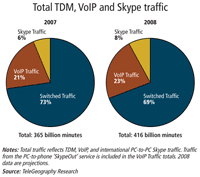In these troubled economic times, telecoms operators are looking at whatever growth they can find to sustain their business. And for all the buzz over new sources of revenue, one of the sector's oldest businesses - international voice calls - is still growing.
Even as competition gets heavier and prices drop, international traffic volumes are on the rise. Stats from telecoms research firm Telegeography indicate that projected international voice traffic at the end of 2008 will hit 385 billion minutes - compared to 343 billion minutes the previous year.
Interestingly, a growing chunk of that is being driven by VoIP and mobile networks. Mobile alone is a key growth driver for IDD these days, thanks to heavy mobile growth in emerging markets and the recent trend of cheap international mobile price plans.
By 2007, according to Telegeography, almost a third of IDD calls originated from mobile phones, and 45% of them were terminated on mobiles. At the current rate, 2009 will be the first year that people will place more IDD calls to mobile phones than fixed lines.
Meanwhile, last year TDM-based international voice accounted for 69% of international voice minutes, compared to 73% in 2007. VoIP (including Skype) accounts for the rest.
That's the good news.
The bad news is that the rise of mobile and VoIP as voice-traffic generators has made the business of actually routing and connecting voice calls a much more complex affair that traditional bilateral agreements aren't equipped to deal with, and is fast reaching nightmare proportions for service providers. Termination prices vary widely between service providers, and things like number portability make it even harder to find the number where the call needs to be terminated.
What's at stake: millions in lost revenue and fraud, and more frequent dropped calls (and thus unhappy customers). And with things expected to get worse before they get better, voice service providers now face a choice: sort it out themselves, or outsource their voice routing so they can get on with the business of selling services to customers.
Everyone has a price
To get a sense of just how complex voice termination is these days, it's worth looking at the Golden Age of bilateral agreements between monopoly telcos on which the IDD system is based.
'History teaches us a lot here,' says John Currie, VP of product management at Pacnet. 'In the old days, international calls could be routed simply based on the country code. If you knew that the country code for the UK was 44 or the code for China was 86, that's all you needed to route that call, and typically you only had to route it to one telco that handled the domestic and international calls. It was a very straightforward process.'
 'Thirty years ago, termination was based on two things: price and quality,' adds Steve Heap, CTO of Arbinet, the bandwidth exchange company that also does plenty of international call routing and termination for both TDM and VoIP traffic. 'Both were simple metrics to work out. Price was, 'How much does it cost to terminate a call from AT&T to BT‾', and the quality was either it worked or it didn't.'
'Thirty years ago, termination was based on two things: price and quality,' adds Steve Heap, CTO of Arbinet, the bandwidth exchange company that also does plenty of international call routing and termination for both TDM and VoIP traffic. 'Both were simple metrics to work out. Price was, 'How much does it cost to terminate a call from AT&T to BT‾', and the quality was either it worked or it didn't.'
Nowadays, most markets are far more competitive, with several landline carriers, including cable TV operators, and mobile operators all originating and terminating calls domestically and internationally, and often at different terminations rates.
Mobile has been a significant game changer in this regard, on a couple of levels. For a start, new 2G mobile operators were typically assigned higher termination rates than fixed-line telcos as compensation for the millions spent on spectrum licenses and infrastructure. And such rates aren't always uniform, says Telegeography analyst Stephan Beckart.
'For example, in some European countries, regulators permit second-tier mobile operators to charge interconnection rates that are a few cents per minute higher than the rates charged by the market leaders,' he says.
As 2G subscribers and traffic volumes grew, many regulators lowered the termination rates for cellcos. But then 3G came along, and with new licenses, regulators set a new batch of higher terminations rates for 3G players that, unlike their 2G predecessors, had to compete in a market where mobile users already existed.
